The Bundesliga is in full swing. Bayern Munich, to nobody’s surprise, are way better than everybody else. Despite a late slip against Augsburg leading to a 1-1 draw, they remain by far the best team in Germany. Here’s what’s going on in the rest of the league.
Schalke are terrible now?
After a surprising second place finish last season, Schalke are currently dead last with zero points. Their underlying numbers paint a slightly better picture, but only slightly. The good news for the side is that defensively they’re clearly running bad. Through their first four games they conceded eight goals. That’s quite a bit worse than the 1.19 expected goals per match you’d expect them to give up. That expected goals conceded number is actually the fourth best in the Bundesliga. Their strategy of uglifying the game, deploying a defensive press and breaking up possession in the opposition half before it can flow into a counterattack is actually working more or less as it’s supposed to. There’s lots of red in all the right places.
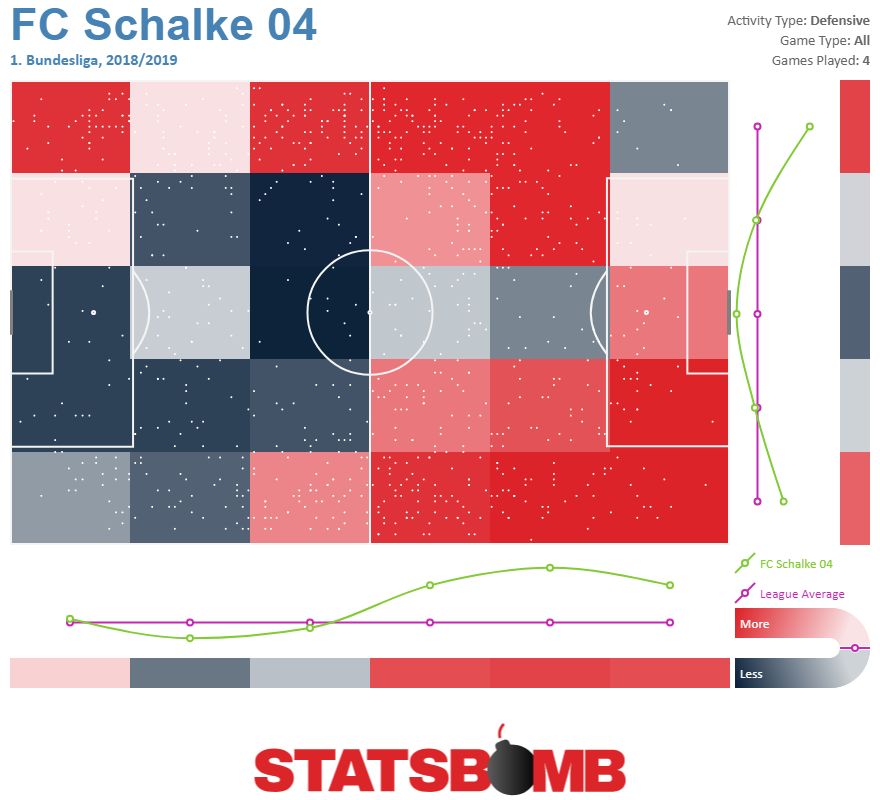
The problem is that teams keep scoring goals anyway.
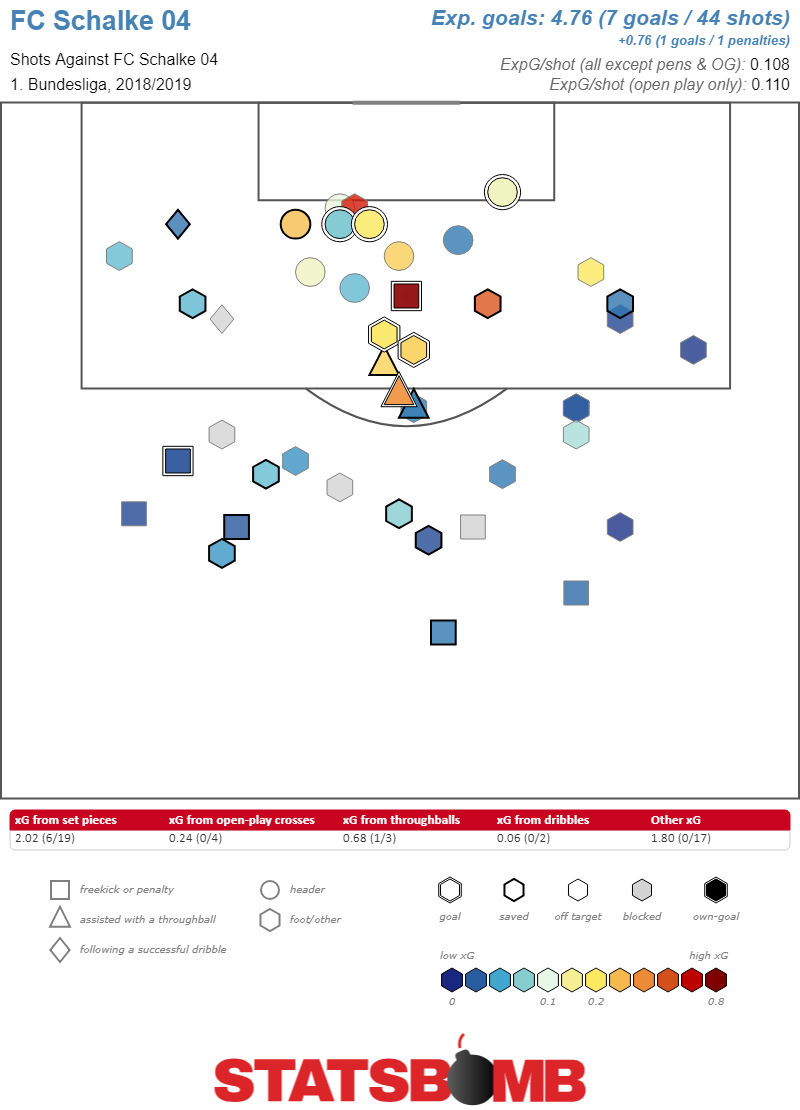
If they keep doing what they’re doing defensively, the goals conceded will likely come back in line, and they’ll return to their stingy ways. The bad news is that with what appears to be an absolutely putrid attack, those stingy defensive ways may not be enough. Schalke are averaging 0.91 expected goals per match through four matches. That’s the second worst total in the Bundesliga. The problem isn’t that they don’t generate shots. They take 13.50 shots per match. That’s almost exactly average for Germany. Eight teams take more. Those shots just simply aren’t good ones. They average 0.07 xG per shot, tied for the lowest in the league. This is just a brutal set of shots.
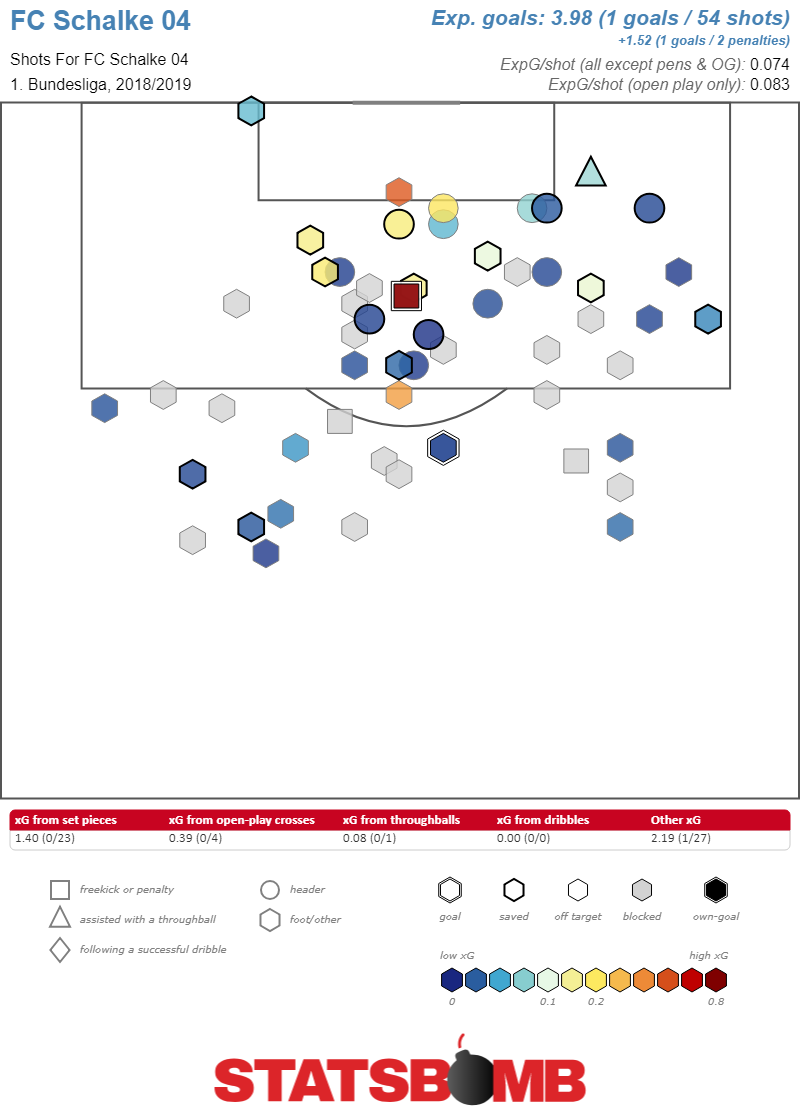
The team presses a lot, and they turn those pressures into shots. They just don’t turn them into effective ones. So, while it's true their attack is running below expectations right now, even if they return to expectations their attack will remain extremely poor. If Schalke have any hope of recovering their season, their attack is going to have to improve, probably dramatically, even as their defense returns to last year’s level of excellence.
High octane Werder Bremen
Werder Bremen appear to have put the proverbial petal to the metal this season. After an entirely indistinct midtable finish last year, they’re currently second, only two points behind the Bayern behemoth. They’ve done that by pushing the throttle all the way open. Their 1.74 expected goals per match are the third highest in Germany. That’s allowed them to rock an expected goal difference of 0.35 that's fourth best in the league (just a shade behind Wolfsburg’s 0.36) despite an average defensive expected goals record. They concede 1.38 expected goals per match, ninth best in the league. The team is playing an extremely possession oriented brand of attack and using the ball to build good chances for themselves. They only take 13.60 shots per game, but their expected goal per shot of 0.13 is second in the league. Of particular note is just how hard Bremen have crushed it from set piece situations. From only 14 shots, they have four goals and 2.73 expected goals.
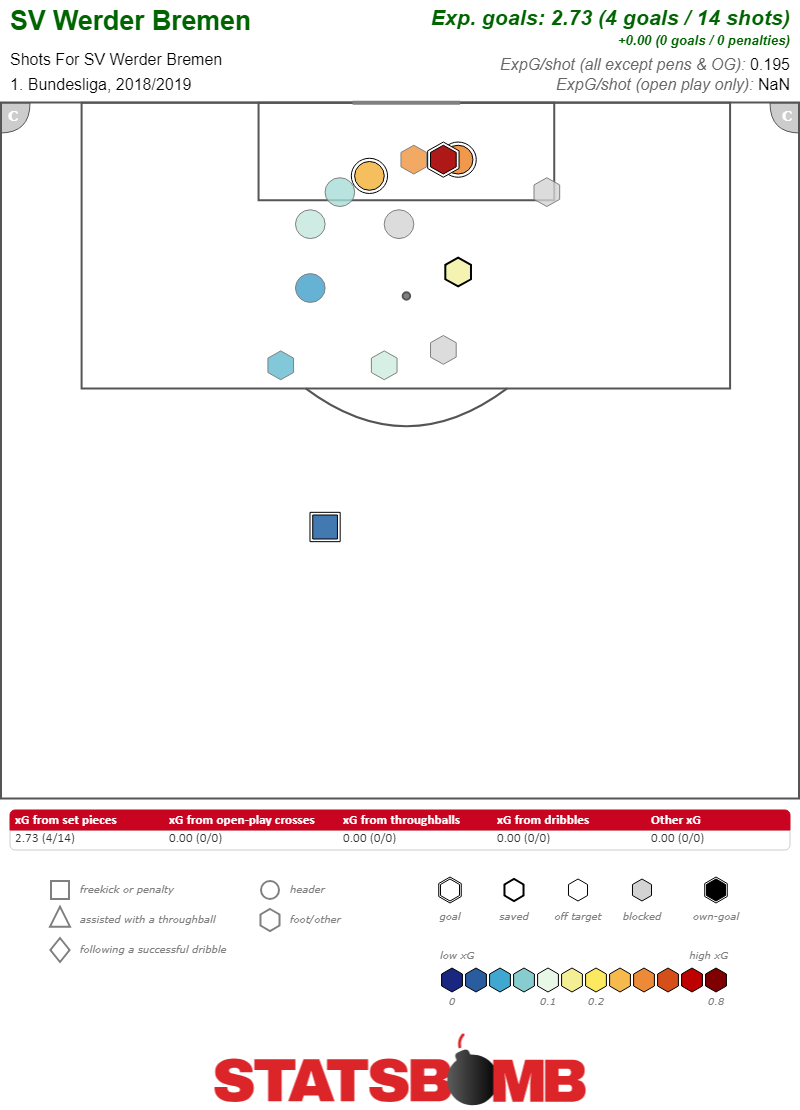
Also of note is just how diffuse the scoring opportunities have been. The team has nine non-penalty goals, but only midfielder Maximilian Eggestein has more than one. Not only is the scoring well balanced throughout the team, but so are the attacking touches. The four players who occupy the front three slots most frequently, Max Kruse, Claudio Pizarro, Martin Harnik and Yuya Osako all see plenty of the ball in the box.
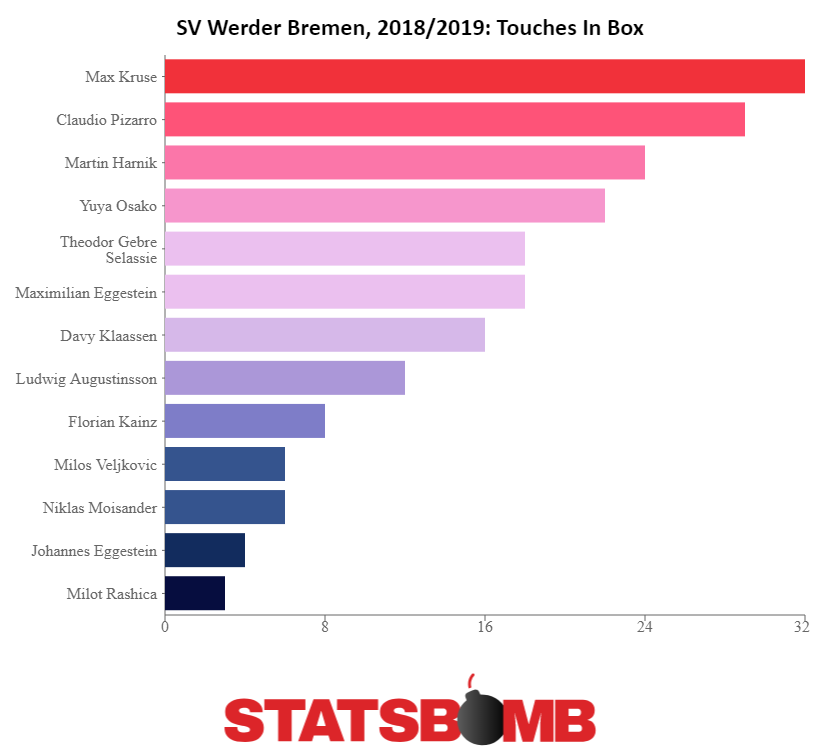
A major concern for Bremen will be their defense's ability to hold up over the course of their season. They’re very aggressive. The average distance from their own goal of a defensive action is 47.21 yards, the third most advanced in the league. And their PPDA (passes allowed per defensive action) is 10.03, the second lowest in the league. So they’re out there running around and trying to turn the ball over. But, for all that pressing they still concede 12.40 shots per match, only the eighth best total. A better version of this team would add a hefty dose of shot suppression to the attacking and defending they’re already doing. That’s Werder Bremen’s challenge for the rest of the season. If they don’t pull it off, they’ll end up being a team that seems fun, but isn’t great (although in Germany this year that still might be enough to qualify for the Champions League), but if the defense improves we might have a really good team on our hands.
Lucien Favre is back to his old tricks
Borussia Dortmund games don’t have many shots. Through four matches the team has averaged only 8.50 shots per match, and conceded only 10.50. That’s the second lowest shots total, and the third lowest shots against total in the league. And the team has a corresponding expected goals problem as well. Their expected goals difference is negative 0.26 per match. And yet, the team has scored eight times and conceded only three. That old Favre expected goal tricking magic is back at work. If Favre didn’t have priors, Dortmund would look like a team primed to tumble down the table. They’re overperforming expectations on both sides of the ball, and doing it for no obviously discernible reason. But, his previous sides, at both Nice and Borussia Mönchengladbach have done the same thing. He is the original xG busting wizard. On the attacking side of the ball the stats make some degree of sense. The side's selective shooting profile coincides with a high expected goal total per shot of 0.13. That’s fourth (marginally behind two other sides with the same value thanks to rounding). That, along with a low reliance on crossing, only 23% of their entries into the opposition penalty area are from crosses, the second lowest in the league, paints an accurate picture of a team striving to build high quality attacks. Add some help from the finishing gods and it all comes together. Their shot chart backs that up.
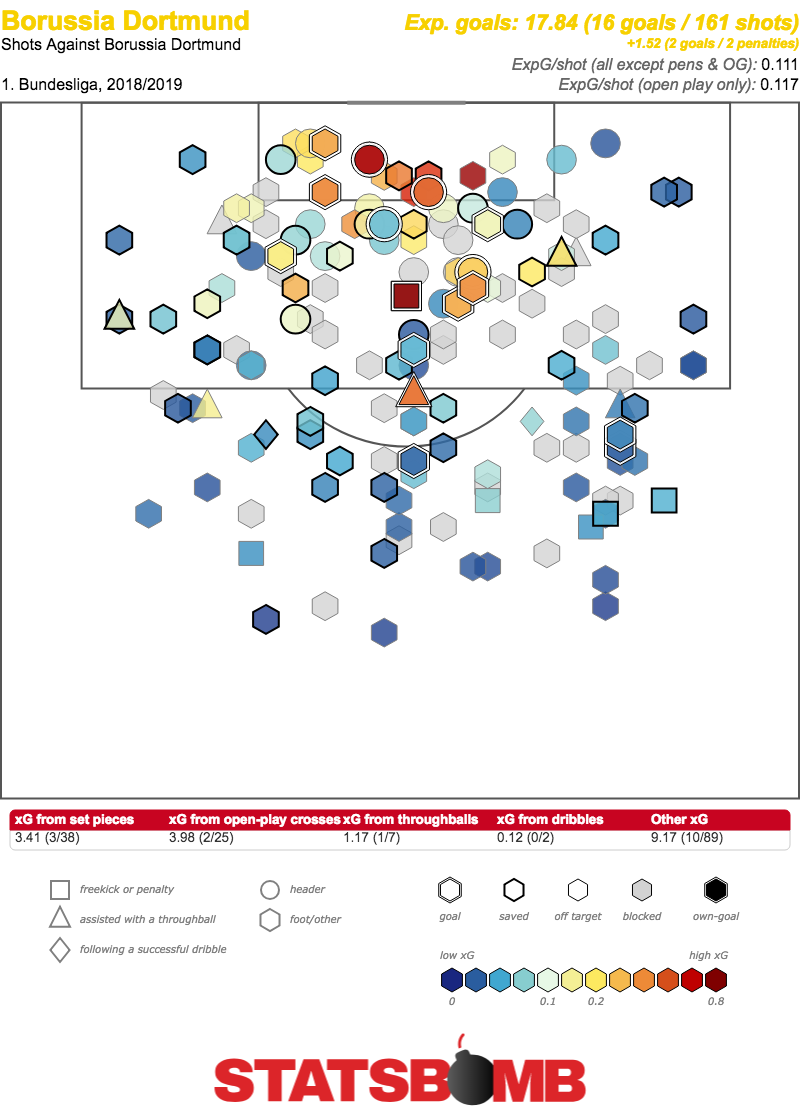
It’s the defensive side of the ball where things get weird. On the one hand they look exactly like a pressing team. They concede few shots, but seemingly good shots. They give up 0.13 expected goals per shot, the third worst total in the league. Their defensive actions are mostly high up the pitch.
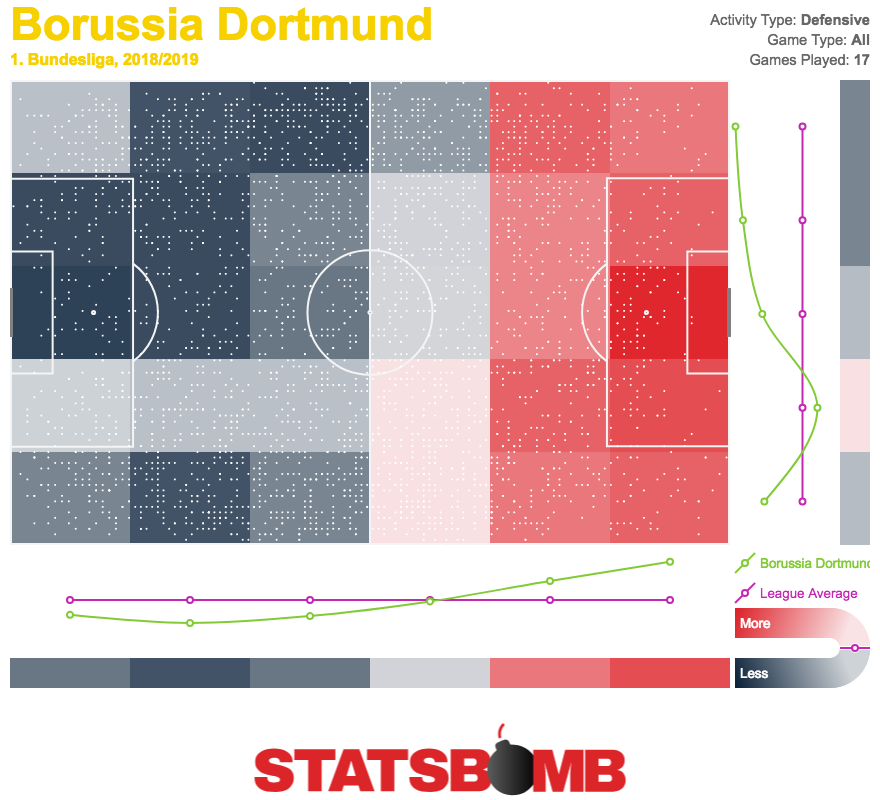
And yet they don’t concede. Somehow they still manage to have defensive cover their own penalty box. Their defensive actions tick back up above average as teams attack their own. And, despite the seemingly high value of the shots they’re conceding, they simply don’t find the back of the net very often. Again, if this was Favre’s first rodeo it would make sense to be cautious drawing conclusions here. But it isn’t. Favre has frequently pulled this trick over the years. The magic of Favre is that his teams muddy up games, and press aggressively in midfield, but also manage to have cover at the back in a manner that seems to trick expected goal models. That’s what Dortmund are doing now, and they’re doing it very well already. It’s a far cry from the wide open attacking side that they’ve been over the years, but after struggling though managerial changes last season, Dortmund at least look like they have a plan fully implemented. It’s not the most attractive football, but it’s worked before, and it sure looks like it’s on its way to working again.